Forgive me for taking a long break in posting. The weekend before last, my husband and I went to the most renowned Food Festival in Poland Poland
The Food Festival in Gruczno takes place every August. This little town is located 500 km from Kraków, and about 100 km from the seaside. It probably is the largest and the most renowned festival of producers of artisanal and organic food products.
Food festivals have developed in Poland Poland Poland Chełmno Gdańsk , the Castle Museum Toruń
I had been hesitating to visit the festival for quite a while and we kind of decided to go there at the last minute. As we did not plan in advance where we could sleep, it was no surprise that the only “Chambre d’Hôtes” we found ad hoc was a stinky rat hole. I usually am not such a maniac as regards to sanitary conditions. But in this place, I was disgusted by the fact that sheets and pillow cases were not fresh. However, we arrived at 1 a .m. after 500 km of driving including 300 km in a huge traffic jam (it took us a total of 10 hours to get there). At that point, the physiological need to sleep was stronger than our will to find a more civilized and cleaner place. All in all, one can put a clean towel on a dirty pillow case and sleep well. The following morning, we got up very early and we arrived at the Festival as one of the first guests, a few hours before its official opening. Thanks to that I could have a few nice chats with several producers.
Around one hundred producers of organic or regional products from the whole country come to Gruczno. Some regions, like the North are better represented than the South or the East (they have their own food festivals). The producers encourage visitors to taste all their products – some of them quite famous, some of them forgotten or not so well known:
Hams (“szynki”), Sausages (“kiełbasy”), Kabanos (“kabanosy” – a thin and long sausage commonly made from pork, sometimes from other types of meat, including horse meat) and other charcuterie products made from pork (the most popular meat used for Polish charcuterie items). Besides pork, I tasted lamb and goat sausages - both interesting in taste (I have never seen them in any shops); Polish traditional charcuterie is cooked and smoked (not all foreigners like that particular smoked taste);
Półgęsek (“goose breast”) – an old dish made from boneless goose breast with the skin on, cured and slowly smoked in cold smoke. In some regions of Poland France Warsaw
Cheeses (“sery”) ; except for oscypek, bryndza and bundz (local and genuine cheeses from the south of Poland, which I already wrote about in my previous posts and fresh goat cheeses, one could find “korycińskie cheeses” (“sery korycińskie”). This cheese is a regional and traditional product from the east of Poland Biebrza National Park 3 kg . With maturity, it changes in taste, color and smell – for example, its texture, which initially is soft, becomes hard over time and its mild cream taste acquires a hint of salt over time.
Unlike bundz, koryciński cheeses are flavored with various herbs and spices. According to a local legend, the method of the cheese production was brought to the region by Swiss soldiers, engaged in the Polish Army during the Polish – Swedish War (“potop szwedzki”) in the 17th century. I further tasted cheeses from a few other producers who make hard cured cheeses of Italian or French styles. Amongst them, I met Rusłan Kozynko who produces cheeses that are close enough to a Parmiggiano, a Pecorino or a French Blue cheese (something between Roquefort and Bleu d”Auvergne
I also visited the booths of two other renowned slow-food producers of hard cheeses. As far as I know, their products are available through their websites.
Powidl (“powidła”) – traditional plum preserves made from Polish plums, fried slowly over a bonfire in huge cauldrons; industrially made preserves are available in every food store; artisanal ones are not so easy to buy;
Fruit Preserves (“konfitury”) – very traditional ones as well as some with the addition of non typically Polish spices and flavors) (for example cardamom, amaretto); as well as naturally pressed fruit juices (“soki”) and fruit syrups (“syropy”);
Venison Charcuterie (“wędliny z dziczyzny”) – sausages and hams prepared from cured boar and roe deer meat. This type of charcuterie was more popular before the Second World War. The tradition to prepare it is reviving slowly now. Venison meat is easily available in food shops in Poland
Nalewka (Liqueur – correct me, if my translation is not proper); It is a general name for a traditional strong alcoholic beverage (usually around 40 %). It is prepared by maceration of herbs, fruits, spices, flowers, sugar, honey and so on. As opposed to regular liquors, “nalewka” usually is aged and must be stored for several weeks, months, or even years, before its final preparation. Very often its name is derived from its main ingredient (for example: apricots (“morelówka”), haw (“głogówka”), juniper (“jałowcówka”). The most renowned manufacturer of home-made “nalewskas”, Mr Hieronim Błażejak from Toruń
Breads (“pieczywo”; “chleby”): all possible types of organic wheat, spelt and rye breads; with the addition of spices, seeds and so on.
Pickles (“przetwory”) – omnipresent sour cucumbers and cabbage, but also pickled mushrooms (“grzybki marynowane”) – such as boletus, lactarius delicious, chanterelles; and other pickled vegetables;
Smoked fish (“wędzone ryby”) – Poland has a lot of lakes; the quality of soft water is unequal now, but there are still some clean lakes, rich with various types of fish. Warm smoking soft water fish have been popular in Poland for ages. Nowadays it is difficult to find good artisanal products like those I saw in Gruczno. This is true with many other products, of course. Distribution channels are weak, too, and in the south of Poland, Northern specialties are rare (in addition, small entrepreneurs cannot afford to have their products carried by big food store chains). Their smoked soft water fish like, for example, smoked eel, was excellent, full of flavor, not too salty and not too dry. On the contrary, smoked tuna and smoked tiger shrimps did not enslave my heart; the fish were awfully expensive (as far as I remember, around 20-25 euros per kilo);
Organic Oils, like, for example - Colza Oil or Linen Oil (the first one made by the Rutkowski family. For years, colza oil had a bad reputation in Poland
Organic Honeys (“miody”) from small apiaries from various types of local trees and flowers; traditional cakes, cookies and sweets; local fruits and vegetables;
Some exhibitors presented foreign organic wines, tea and cider from the Basque country or Greek products including halva (of which I am not a great fan).
Aside from the products that were presented, one could also taste some regional dishes, such as: traditional dumplings, regional soups (for example, a type of sour cabbage soup from the Podhale region – “kwaśnica”; buttermilk soup; fried or marinated fish; baked potatoes with fillings; sausages, hunter’s stew – “bigos”, meats, including venison). Nevertheless, I can no longer look at the traditional, huge slices of bread spread with lard - pork’s fat (“smalec”) and topped with sour cucumber. This peasant, particular preparation despite the change of a political system, is still the king of food festivals!
Finally, I was absolutely fascinated by Barbara Rożniak’s products. Her clay plates, pots, pans and jugs take you into the early Middle Ages. They are made using original methods from the Middle Ages, and for the purpose of rediscovering them, Barbara has visited numerous archeological sites. She is regularly invited to many events in Poland

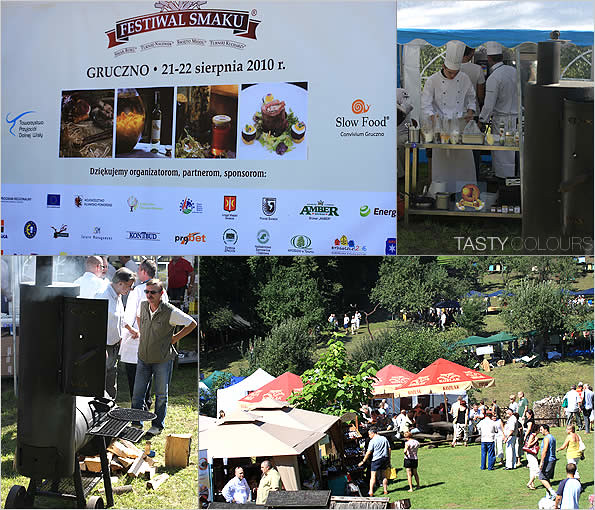


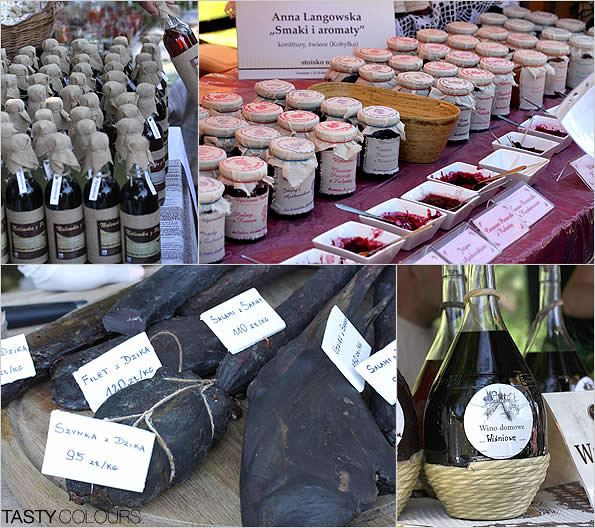
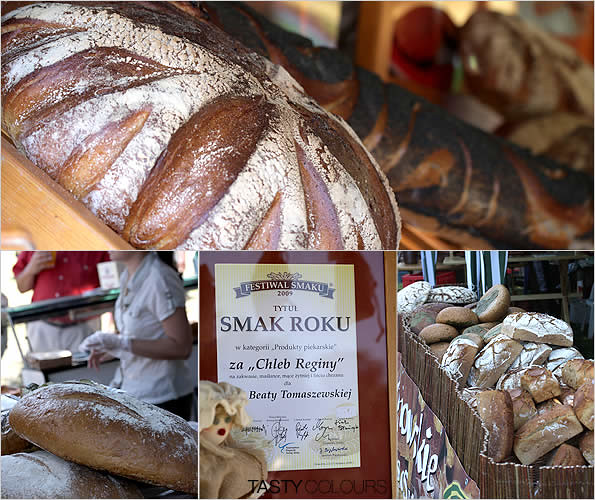


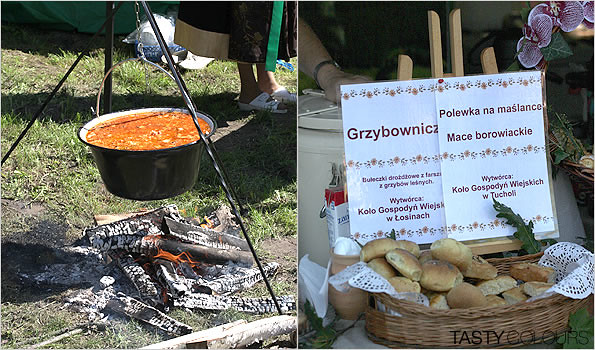
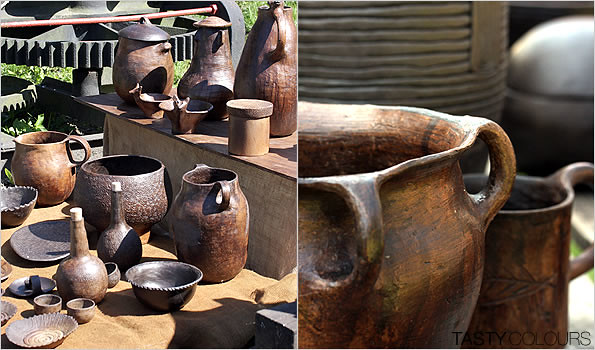







13 comments:
Magda, to i ty tam byłaś i miód i wino piłaś ?
Wspaniały reportaż ! Fajnie, że znów jesteś w sieci.
wspaniały reportaż :) dziękuję i mam nadzieję wybrać się za rok :)
Wspaniale opisany Festiwal, aż żal że się tam w tym roku nie wybrałam. Ale na szczęście zapowiada się, że to będzie już stała impreza :)
Ale co ważniejsze to prawdziwa przyjemność poczytać o tym po angielsku u Ciebie - uwielbiam te lekcje angielskiego :)
Ściskam cieplutko :*
I have died and gone to heaven!
I am of Polish heritage, you know! Seeing this was quite wonderful.
Thanks so much for sharing:)
What a great post and reading about all the food. Wish i could be there.
Witaj, Magdaleno, relacji jeszcze nie czytałam, ale zapraszam Cię do zabawy:
http://kaszaprodzekt.blogspot.com/2010/09/wasciwie-to-kilka-rzeczy-lubie.html
Magdo, i ja Cie upolowalam:
http://zmyslywkuchni.blogspot.com/2010/09/dostalam-zaproszenie-do-zabawy.html
:)
Usciski!
Nice place (minus the dirty linen)! Great article, beautiful pictures as always. And you've managed to capture a Polish mustache bearer - excellent! A proper tash on a proper man's face is a sight rarely seen nowadays.
As regards nalewkis and liqueurs, there is a slight yet significant difference between the two. Both are flavoured alcohols, that's for sure, but liqueur is usually spirit sweetened and watered down with some sort of syrup, whereas nalewka is made by macerating flavoursome ingredients in distilled spirit, usually for a long period of time. The resulting alcohol is therefore more "noble", if I may use such term, than a liqueur, even if the liqueur is Grand Marnier Cordon Rouge. Technically speaking, gin is a type of nalewka, being a spirit infused with juniper and other spices. The Polish name for gin is jałowcówka (from jałowiec = juniper). In similar manner, malinówka will be raspberry nalewka (malina = raspberry), orzechówka - walnut nalewka (orzech = (wal)nut), głogówka - haw, anyżówka - aniseed, kawówka - coffee, piołunówka - wormwood, wiśniówka - cherry, and so on, the varieties are as many as there are many different herbs, spices and fruits to give flavour to spirits.
Yeah I couldn't sleep with knowing the sheet and pillow were not fresh! That seemed like a really great event and worth the trip. Goose breast? Hmm..I wanna try this!
O Magda, to na takiej wyprawie bylas - piekne przywiozlas zdjecia i fajnie to opisalas. Dobrze, ze jest ten festwal i chcialo by sie wiecej, tak by nie musiec planowac calych wakacji by sie tam wybrac :)
A co najbardziej Cie zachwycilo, co najbardziej smakowalo, a co rozczarowalo?
Pozdrawiam!
Uwielbiam takie imprezy. Byłabym w swoim żywiole.
Obowiązkowa lekcja polskiej kuchni dla każdego cudzoziemca ;)
Magdo, niesamowity reportaz! Bardzo zaluje, ze mnie tam nie bylo... Ale kto wie, moze i mnie sie kiedys uda do Gruczna zawitac?
Jestem pewna, ze niezwykle trudno by mi bylo zdecydowac, co powinnam kupic (najchetniej bowiem kupilabym wszystkiego po trochu ;)).
Pozdrawiam serdezcnie!
thats really great topic thanks for shearing
Using the services offered by our car purchase is extremely simple and quick. Each client is provided with professional service and advice. Formalities are kept to a minimum and the cash is paid immediately. Unfortunately, you will not receive money in the commission so quickly - you should be prepared for a large amount of formalities. For more at
Skup samochodów
Post a Comment